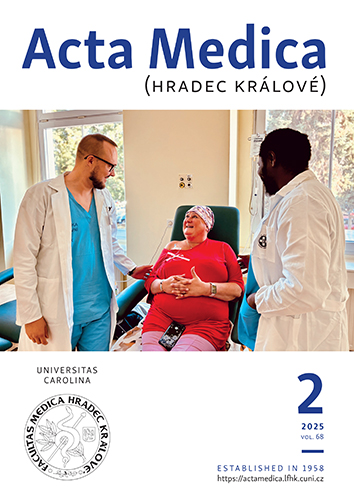ACTA MEDICA, Vol 65 No 2 (2022), 45–52
High Flow Nasal Cannula Therapy in the Emergency Department: Main Benefits in Adults, Pediatric Population and against COVID-19: A Narrative Review
Eduardo Esteban-Zubero, Cristina García-Muro, Moisés Alejandro Alatorre-Jiménez, Vickramjeet Johal, Carlos Arturo López-García, Alejandro Marín-Medina
DOI: https://doi.org/10.14712/18059694.2022.17
published online: 02. 12. 2022
abstract
This review aims to summarize the literature’s main results about high flow nasal cannula therapy (HFNC) HFNC benefits in the Emergency Department (ED) in adults and pediatrics, including new Coronavirus Disease (COVID-19). HFNC has recently been established as the usual treatment in the ED to provide oxygen support. Its use has been generalized due to its advantages over traditional oxygen therapy devices, including decreased nasopharyngeal resistance, washing out of the nasopharyngeal dead space, generation of positive pressure, increasing alveolar recruitment, easy adaptation due to the humidification of the airways, increased fraction of inspired oxygen and improved mucociliary clearance. A wide range of pathologies has been studied to evaluate the potential benefits of HFNC; some examples are heart failure, pneumonia, chronic pulmonary obstructive disease, asthma, and bronchiolitis. The regular use of this oxygen treatment is not established yet due to the literature’s controversial results. However, several authors suggest that it could be useful in several pathologies that generate acute respiratory failure. Consequently, the COVID-19 irruption has generated the question of HFNC as a safety and effective treatment. Our results suggested that HFNC seems to be a useful tool in the ED, especially in patients affected by acute hypoxemic respiratory failure, acute heart failure, pneumonia, bronchiolitis, asthma and acute respiratory distress syndrome in patients affected by COVID-19. Its benefits in hypercapnic respiratory failure are more discussed, being only observed benefits in patients with mild-moderate disease. These results are based in clinical as well as cost-effectiveness outcomes. Future studies with largest populations are required to confirm these results as well as establish a practical guideline to use this device.
keywords: emergency; oxygen; respiratory diseases; high flow nasal cannula; pediatrics; COVID-19

High Flow Nasal Cannula Therapy in the Emergency Department: Main Benefits in Adults, Pediatric Population and against COVID-19: A Narrative Review is licensed under a Creative Commons Attribution 4.0 International License.
210 x 297 mm
periodicity: 4 x per year
print price: 150 czk
ISSN: 1211-4286
E-ISSN: 1805-9694
